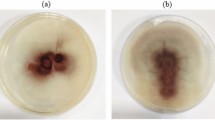Abstract
The paper studies diploids in dermatophyteMicrosporum gypseum. They were isolated as the more rapidly growing sectors from heterokaryons on minimal medium. They are characterized by their wild morphology, conidiation and growth rate, and they are prototrophic. In their genome they contain all the markers present in both mutant components.
Similar content being viewed by others
References
Buxton, E. W. (1956) Heterokaryosis and parasexual recombination in pathogenic strains of Fusarium oxysporum. J. Gen. Microbiol. 15: 133–139.
Casselton, L. A. (1965) The production and behaviour of diploids of Coprinus lagopus. Genet. Res. 6: 190–208.
Dvořák, J. & Otčenášek, M. (1969) Mycological diagnosis of animal dermatophytoses. Academia Praha.
Garza-Chapa, R. & Anderson, N. A. (1966) Behavior of single-basidiospore isolates and heterokaryons of Rhizoctonia solani from flax. Phytopathology 56: 1260–1268.
Hejtmánek, M. & Lenhart, K. (1964) Zur Biometrie der Sporen bei Pilzkulturen, insbesondere bei Dermatophyten. Mykosen 7: 43–53.
Hejtmánek, M. & Lenhart, K. (1972) Genetic complementation of virulence in avirulent mutants of Microsporum gypseum. Folia Biologia (Praha) 18: 225–230.
Hejtmánková-Uhrová, N. (1966) Über eine Methode der Mikrokultivierung der perfekten Stadien und die Ascosporen — färbung bei Microsporum gypseum (Bodin) Guiart et Grigoraki. Mycopathol. Mycol. Appl. 29: 182–186.
Hejtmánková, N. & Hejtmánek, M. (1965) Über die Induktion der sexuellen Vermehrung und die genotypische Determination der Wuchsform bei Microsporum gypseum (Bodin) Guiart et Grigoraki. Mycopath. Mycol. Appl. 25: 183–194.
Hejtmánková, N. & Hejtmánek, M. (1969) Collection of dermatophytes and keratinophilic fungi. In: Catalogue of cultures. Brno.
Ikeda, Y. K., Nakamura, K., Uchida, K. & Ishitani, C. (1957) Two attempts upon improving an industrial strain of Aspergillus oryzae through somatic recombination and polyploidisation. J. Gen. Appl. Microbiol. (Tokyo) 3: 93–101.
Käfer, E. (1961) The processes of spontaneous recombination in vegetative nuclei of Aspergillus nidulans. Genetics 46: 1581–1609.
Lenhart, K. (1965) Killing and mutagenic effect of UV-radiation on spores of Trichophyton terrestre Durie et Frey 1957. Ztsch. Allg. Microbiol. 5: 222–227.
Lenhart, K. (1973) Heterokaryosis in Microsporum gypseum. Mycopath. Mycol. Appl. 49: 109–120.
Lenhart, K., Hejtmánek, M., Hejtmánková, N. & Kunert, J. (1972). Biochemical mutants of Microsporum gypseum. Acta Univ. Palack. Olomuc. fac. med. 63: 115–130.
Lenhart, K., Lenhartová, E., Komenda, S. & Braunerová, Z. (1971). Discriminant analysis and perspectives of numerical taxonomy in dermatophytes. Acta Univ. Olomuc. fac. med. 59: 17–39.
Lhoas, P. (1967). Genetic analysis by means of the parasexual cycle in Aspergillus niger. Genet. Res. 10: 45–61.
MacDonald, K. D., Hutchinson, J. M. & Gillett, W. A. (1965) Heterozygous diploids of Penicillium chrysogenum and their segregation pattern. Genetics 36: 378–397.
Pathak, S. G. & Elander, R. P. (1971) Biochemical properties of haploid and diploid strains of Penicillium chrysogenum. Appl. Microbiol. 22: 366–371.
Purnel, D. M. (1971) Effects of specific genotypic alternations on the virulence of Aspergillus nidulans for mice. Microb. Genet. Bull. 33: 14–15.
Roper, J. A. (1966) Mechanisms of inheritance. 3. The parasexual cycle. In: The fungi (edited by G. C. Ainsworth & A. S. Sussman), vol. II. Academic Press, New York and London.
Vest, G. & Anderson, N. A. (1968) Studies on heterokaryosis and virulence of Rhizoctonia solani isolates from flax. Phytopathology 58: 802–807.
Wood, S., Käfer, E. (1969) Effects of ultraviolet irradiation on heterozygous diploids of Aspergillus nidulans. I. UV — induced mitotic crossing over. Genetics 62: 507–518.
Author information
Authors and Affiliations
Rights and permissions
About this article
Cite this article
Lenhart, K., Hejtmánková, N., Lenhartová, E. et al. Diploids in Microsporum gypseum. Mycopathologia et Mycologia Applicata 54, 253–266 (1974). https://doi.org/10.1007/BF02050045
Accepted:
Issue Date:
DOI: https://doi.org/10.1007/BF02050045




